Battle of the Bulge |
Table of Contents |
Adj. Notes and Stats |
Battle of the Bulge |
Table of Contents |
Adj. Notes and Stats |
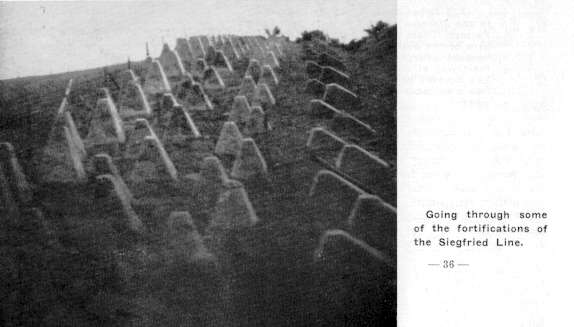 The
most of the month of February was to prove relatively uneventful; the first
three weeks or so were to witness methodical, then gradual accelerated
preparations for the ultimate assault of the big bugaboo we had heard so
much about during our military careers, THE SIEGFRIED LINE. But, it was
not only for the breaching of this heralded line of fortifications that
we massed troops and materials; we intended, once through, to go all the
way, and bring Hitler's teetering, punchdrunk Germany to its knees with
a series of merciless blows, and then finish it off with our specially
trained Sunday Punch. That was inevitably to come.
The
most of the month of February was to prove relatively uneventful; the first
three weeks or so were to witness methodical, then gradual accelerated
preparations for the ultimate assault of the big bugaboo we had heard so
much about during our military careers, THE SIEGFRIED LINE. But, it was
not only for the breaching of this heralded line of fortifications that
we massed troops and materials; we intended, once through, to go all the
way, and bring Hitler's teetering, punchdrunk Germany to its knees with
a series of merciless blows, and then finish it off with our specially
trained Sunday Punch. That was inevitably to come.
So, we probed and reconnoitered, shifted troops and supplies. Our part in this preparation wasn't very tactically active, for while we maintained our defensive positions on Skyline Drive, there was a minimum of action. We supported. We carried on a program of rest, rehabilitation, and maintenance, and groomed ourselves for the ensuing action. Two vital bridges and bridgeheads across the Our River in our sector were secured and improved.
Then, on the 17th, things began to cook. Company "B" (--) was attached to Task Force Brown; on the following day, one platoon of Company "A" and one platoon of Company "B" were attached to Task Force Brindle, Company "A" (--) and the Mortar Platoon were attached to Task Force Britton; the Assault Gun Platoon was attached to the 128th Field Artillery Battalion. Also, on the 19th, Company "C" was attached to Task Force Ward, and Task Force Davall, composed of the remaining elements of CCB, formed and constituted CCB's Reserve.
At dawn
on the 20th the above mentioned task forces of CCB jumped off and by darkness
had secured their initial objective along Skyline Drive east of the Our
River. On the following day, Company "D," part of Task Force Davall, moved
across the river into a forward assembly area on the high ground north
of Dahnen (Germany!). The rest continued the attack north and south
from the second and third objectives. We were through the LINE and were
expanding our salient! The fighting was initially bitter, and the krauts
refused to come out of their reinforced pillboxes until they were blown
out by engineer demolitions, But, in general our softening up prelude by
both air and ground had been successful, and we went pouring through. Task
Force Britton had flanked Dasburg from the northeast, and Task Force Ward,
subsequently committed, had swung northeast and then south to take Daleiden.
There was barely a rock standing in these towns so devastating had been
our air and artillery preparations. Now that we were through the line,
and the enemy was threatened with our outflanking him in every position
he chose to defend. Jerry was desperately trying to salvage what he had
left, and to pull out, but fast, with every means he could lay his hands
on. So we naturally wanted to close his escape gap, and for this mission
a specially formed task force under Col. Davall was formed. Things were
breaking so fast now that there was no longer time for studied, deliberate
planning -- only action hard and fast!
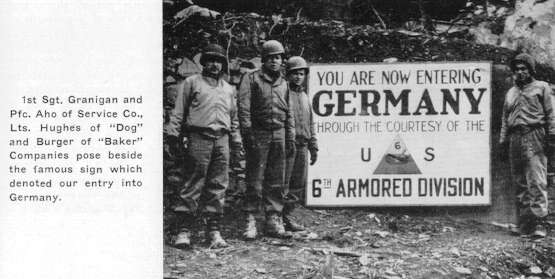
So, on February 23rd, Task Force Davall was ordered to Reuler, and then immediately dispatched to Jucken. At Jucken a new special task force was formed, consisting of: The Reconnaissance Platoon, Companies "B" and "D," one platoon of Company "A" plus Troop "D" of the 86th Recon., Company "A" of the 44th AIB, one platoon of Company "A" 603rd TDs and two squads of Company "A", 25th Armored Engineer Battalion. Our mission was to block the enemy routes of withdrawal along the axis Zweifelscheid -- Leimbacb -Kreuzdorf -- Ackelshof -- Obergeckler, and establishing contact with the 80th Infantry Division swinging up from the south to meet us. It was an end run play, with the accent placed on speed and surety. One platoon of Troop "D", reinforced with one squad of engineer mine sweepers, took off at 1640. Resistance was first encountered at Karlshausen, and this town was cleaned out with the co-operation of elements of the 6th Cavalry Group which drove in from the southwest, By midnight, on a night that was pitch dark, Col. Davall's men had driven on and captured the towns of Finnehof, Wolperdorf, and Leimbach. Teller mines hastily strewed on the road and in the ditches were reported here by Lt. Burns, Reconnaissance Platoon Leader, and were immediately removed. The above mentioned towns were occupiedby elements of Task Force Brown after our capture, and we pushed on. The task force then continued its drive to the south, clearing and capturing Hutten, Neuhutten, and Kreuzdorf. When road blocks were established on all approaches to Kreuzdorf at 0430, patrols from Troop "D" set out to contact the 80th Division. Finally, in the vicinity of hill 502 between Obergeckler and Kreuzdorf elements of the dough division were contacted; also we contacted friendly elements of the 6th Cavalry Group on our right flank.
We held
what we had accomplished on the following day, and at 1200 one platoon
of Company "A" 44th AIB occupied Neuerberg across the Enz River. When elements
of the 6th Cavalry had relieved this dough platoon at Neuerberg, Task Force
Davall was dissolved and all elements reverted to their parent units. So
ended an extremely difficult, yet brilliantly directed and ably accomplished
mission. The 68th Tank Battalion, once more intact, was released from CCB,
attached to CCR, and returned to the general vicinity of Neuhutten. The
various companies moved into billets, and settled down to a program of
rest and maintenance.
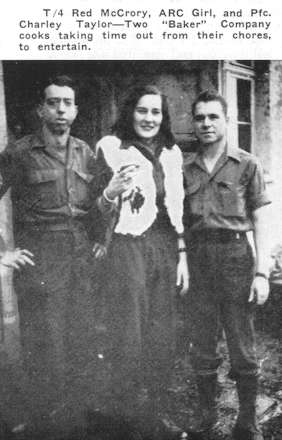
The remainder
of the month of February was uneventfully passed, with occasional bridge
guard details, and so we rested and prepared for our next assignment.
On the first of March, Companies "C" and "D" relieved Troops "E" and ''F'' of the 86th Cavalry Reconnaissance Squadron respectively. With the Assault Guns and Mortars in direct support, they continued the battalion's defensive mission in their assigned sector. By systematic patrols, contact with adjacent units was maintained. On the next day, in an incessant downpour, a tie-in point with the 4th Division at Watzerath was arranged, and the battalion continued its defensive mission without change or mishap, The same is true of the succeeding day both of continued rains and also of active defense with out incident, and then on the 4th of March Companies "D" and "C" were relieved of their sector and returned to their former billets. The battalion remained in CCR.
From the
5th to the 9th of April, the 68th's position was unchanged, and during
this period there was initiated and followed a program of instruction in
vehicular driving and maintenance; we had meanwhile gained a considerable
number of reinforcements many of whom had never received armored instruction,
and this was an excellent time to indoctrinate them into the technique
of armored operation and necessary maintenance. Also, during this period
the men had time to rest, catch up on correspondence, and see the latest
moving pictures.
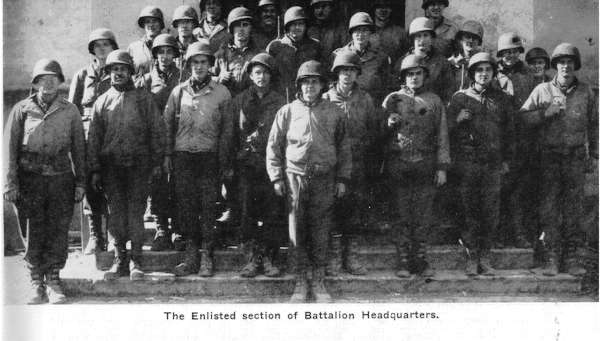
Then, on
the tenth of the month, the battalion was ordered with the division to
proceed to the vicinity of Dieuze, France. We crossed the IP at Karlshausen
at 0710, and continued through Diekirch, Ettelbruck, Luxembourg, Thionville,
and Pont-a-Moussen to the vicinity of Vi-Sur-Seille, Eezy, Juvelize, and
Blanche Eglise. Although we remained in CCR, the division was now under
7th Army control. To clarify this a bit, the 7th Army on the south sector
of the entire line had not been able to keep abreast of the 3rd in the
north, were massing for their breakthrough of the Siegfried Line, and requested
the "Super Sixth" to help them in their undertaking. So, the 4th Armored
was given the beautiful set-up to break through on the north and dash unimpeded
to the Rhine, while the ever-dependable 6th was loaned out to the 7th to
again break through this line near Zweibrucken across the Saar. Tankers,
what now! The entire division was marched to the 7th Army area. Out of
Germany and back into the Saar again. We were going through the Siegfried
Line again!!
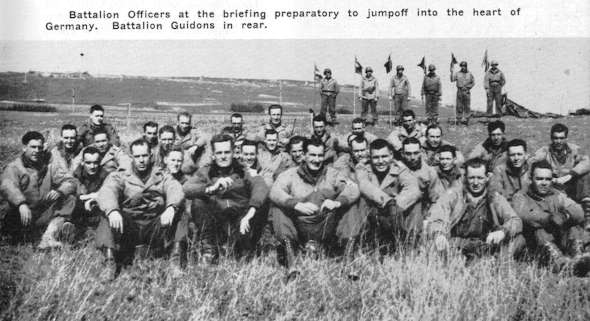
So, from the 10th to the 17th, we shifted our training locations a bit in thegeneral area, and prepared assiduously for the task ahead. We tried out all our new 76mm. guns, and the men grew used to them; it was a good thing, because the new gun, with its muzzle brake, and greatly increased velocity, was fired with a stunning blast to those inside the tanks, and experience in handling the weapon was imperative. We continued to train recent replacements, and carried on our maintenance so that when the day arrived we were in the best possible shape.
On March 17th, the battalion, still in CCR, received warning orders anticipating movement to a forward assembly area northeast of Sarre-Union, and became Task Force Davall, composed of Companies "A" and "D," 68th Recon. Company, 603rd TDs, one platoon of Company "C" 25th Engineers, and Company "A," 50th AIB. On the 18th, Combat Team Davall marched with CCR to its forward assembly area. We beg your pardon, but such an aggregation of troops is called "Combat Team" in the Seventh Army! and closed in its new area at 1415.
Just before noon on the 19th, we moved out to pass through two veteran infantry divisions which had been assaulting the Siegfried Line for the past several days. The column was hampered by poor road conditions, so its initial advance was slow, but we passed through Zweibrucken shortly after midnight; we had as yet met no opposition, for the doughs had pretty well erased the previously formidable line. Still hampered by poor traffic conditions and the delay of forces ahead of it on a poor road net, the combat team advanced slowly. Then, we started to shake loose, and shortly after noon on the 20th, we streaked rapidly to the vicinity of Gerardsbrunn against no organized oppositions; numerous elements of disorganized, highly confused enemy forces formed a continuous stream of apathetically waved white flags along the column's axis of advance, Countless liberated slave laborers also choked the roads in a rear-ward trek.
The Assault
Gun Platoon fired on observed mission on a horse-drawn artillery column
with excellent effect at co-ordinates (862835). Then, Battery "A" of the
231st Field Artillery Battalion joined us at Altheim. At 1630, we assembled
in the vicinity of Gerardsbrunn and awaited further orders. Subsequently,
we received orders to proceed to Grundstadt, and moved out promptly. The
breakthrough had been complete and as we swept along we continuously contacted
friendly columns all racing to the Rhine.
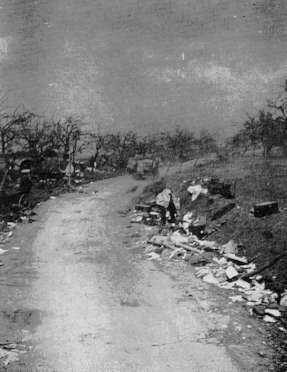

Having marched all night, Combat Team Davall closed at Hettenleidheim at 0500 on the 21st, where we bedded down for much rest. Then, refreshed again, we moved to a new area west of Grunstadt the following noon; Battery "A" 231st was relieved from attachment here, and we settled down to rest and reorganize for future operations.
We spent three days in our bivouac west of Grunstadt, until on the 25th we proceeded east and prepared to cross the Rhine. At 1730 the column continued east, crossed the river at Oppenheim, and thence made its way swiftly to the vicinity of Gross Gerau. The weather was ideal and we boiled along, virtually unopposed. At 1800, Lt. Col. Davall assumed command of CCR, and Major Daniel E. Smith assumed command of the combat team; Combat Team Smith closed in bivouac at 2000, and on CCR order, Werfelden and Scheppenhausen were reconnoitered and found to be in friendly hands.
On the
next morning, the combat team instituted a road reconnaissance to the cast
in anticipation of a possible move in that direction; one platoon from
Recon. Company 603rd TDs reconnoitered the route to the vicinity of Langen.
Then at 1730 we left our bivouac area, and proceeded north to the vicinity
of Gespitz where Col. Davall resumed command of the combat team. The following
day, we remained there, and took many prisoners, as they willingly came
in to surrender from isolated out-flanked positions.
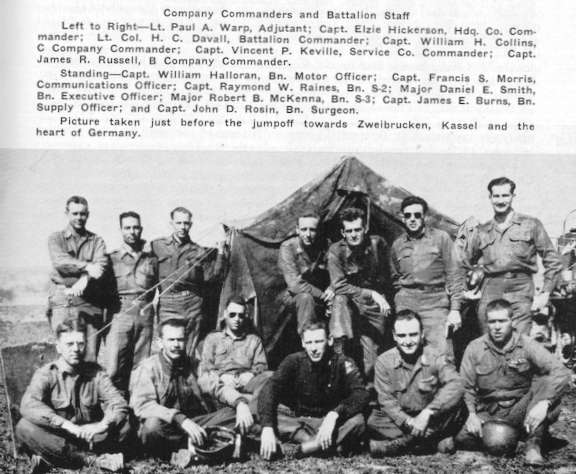
Next we proceeded from our bivouac area and proceeded northeast to cross the Main River. Other elements of the division, unable to take the city by storm, and hampered by enemy shellfire which interrupted their attempts to secure a suitable bridgehead in Frankfurt, finally slid off to the east to by-pass Frankfurt, and left the complicated, time necessary assault of Frankfurt to doughs, who had by this time come up to relieve us. After crossing the river under cover of smoke, the column roared to a temporary assembly area several miles east of the river and closed there at 2230. At 0700, on the 29th, the combat team moved north through Nieden, Gross Karken, Assenheim, Berstadt, Griedel, and thence north on the autobahn (super-highway) to an assembly area near Oppenrod. This was a lightning thrust, and sporadic small arms and bazooka fire were encountered and dealt with summarily. The combat team suffered, however, no casualties, and captured an estimated thousand prisoners, although there were doubtless many more which could not be accurately tabulated, so swift was the advance. We closed in our new area at 1700, and prepared for further operations to the east.
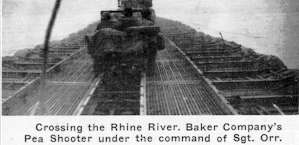
Our drive was really under a full head of steam, and our opposition for the most part were not crack troops, but rear echelon commandos of the Wehrmacht. Surprising too, was the total lack of willingness to fight of the widely heralded Volksturm, old men and young boys, who, mutely bedraggled, lifted not a hand in resistance. In the vernacular, "'They had had it!"
On the 30th, having lost Recon. Company 603rd TDs but having gained the 274th FA Bn., we shoved off in a generally northeasterly direction through Geilhausen, Obergleen, Wasenburg, Michelburg, Utterhausen, and Zennern, where we closed at 1020. This rapid thrust into the heart of Germany covered 66 miles; some small arms fire was encountered, but it was quickly disposed of. Then, immediately on arrival at Zennern, Company "B" crossed the river to Ober Molrich in order to relieve cavalry elements already there. They underwent extremely heavy artillery fire while crossing. Later that night Company "C" reinforced Company "B"' and also when combat team reconnaissance elements reached Wabern and Zennern, they received small arms and bazooka fire, as a result of which one attached tank destroyer was crippled, but the combat team subsequently inflicted heavy casualties on the enemy, and cleaned them out successfully. Then, too, during the night the Assault Gun Platoon fired missions to protect our bridgehead. One platoon of 603rd TDs was attached to the combat team, and we remained under the control of CCA.
On March
31st, Company "B," led by Captain Russell, and one platoon of "A" Company
50th AIB attacked Werkel from the south during which attack they encountered
heavy direct self-propelled and mortar fire, and were forced to withdraw
to the vicinity of Ober Molrich. Then, an air strike was requested, and
P-47s consequently bombed and strafed the town, Next, Company "C" and a
platoon of armored infantry attacked Werkel again, this time from the southwest,
and lead elements succeeded in battering their way into town after a bitter
fight. By midnight, Company "K" 261st Infantry Regiment, meanwhile attached,
secured the bridge at Werkel, and were further reinforced by elements of
the combat team, which made preparations to move in. We remained in CCA.
The beginning of April found Combat Team Davall continuing the attack, driving north to penetrate the defenses of Kassel. It is noteworthy that Colonel Davall's command was still the main driving, unchecked force in the division, as the other elements were probing and reconnoitering routes and possible river crossings to the east. Shortly after the jump off at 0820, lead elements ran into considerable small arms and self-propelled antitank fire at the outskirts of Gudensberg. However, this opposition was thoroughly dispersed and swiftly cleaned up, and the combat team went into a tightly tied-in assembly nearby. We quickly organized the town, and waited there for further orders. Then, later in the day, we were relieved by the 3rd Battalion, 261st Infantry Regiment, and were alerted to be prepared to cross the Fulda River the next morning; the division commander had elected, since CCA could not find a suitable crossing of its own, to shove them across on a bridge farther south secured by CCB,
So, on the following day, the column, refreshed by the maximum amount of rest under the circumstances, moved out to the south and in rapid succession passed through Zennern, Singlis, Hebel, and then swung east to cross the Fulda at Malsfeld; we continued in a north-easterly, then easterly direction, and reached Eschenstruth at 2010. Moderate resistance was encountered here, and also at Quentel and Furstenhagen, but it was cleaned out completely without loss; we had secured these towns by 2200, and prepared for further movement to the east.
At 0700
on the 3rd, Task Force Davall continued its easterly advance, passing through
Walbourg, and Wickerode. We might mention here that other elements of CCA
had continued advancing the preceding night and this morning, under extremely
fatiguing conditions, pitch darkness, rain, mud, and a tortuous, hilly
route. However, this morning we negotiated the same distance in a fraction
of their elapsed time, and also our men refreshed by a night's sleep and
really ready to go. At 1445 we closed in the vicinity of Hitzerode, in
which general area the other elements of CCA had assembled. Reconnaissance
elements were ordered to find a crossing over the Werra River, our next
natural obstacle, and, in checking the bridge west of Bad Sooden, encountered
a strongly defended road block, also, at 1430 heavy artillery and bazooka
fire were received in that vicinity. So with this knowledge, Colonel Davall
organized a task force composed of one medium tank platoon, a light tank
platoon, reconnaissance platoon, and Company "K" 261st Infantry to reduce
the block and secure the bridge at Bad Sooden. However, just as final coordination
of the attack was being effected, the show was ordered stopped by higher
headquarters; the task force was withdrawn, and during the withdrawal further
small arms, mortar, and self-propelled anti-tank fire was received although
our supporting 274th FA Bn. fired continuous protective barrages, and continued
with interdictory fires. With the above accomplished, we prepared to move
cast again.
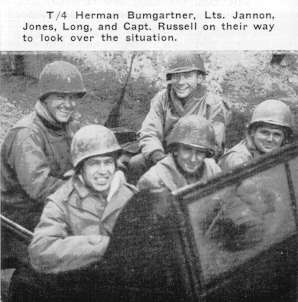
Early on the morning of the 4th, we crossed the Werra River at a point secured farther south than our former position, and swiftly bowled along to the vicinity of Struth, where we assembled in readiness for participation in the attack of Mulhausen. Then, as part of the general encirclement of the city before the division's attack, the task force moved to Lengefeld; Company "B," plus a platoon of FOX (Company "A" 50th AIB), was ordered to attack and secure Ammern, and this force accomplished its mission without loss by 2200, while capturing some thirty odd prisoners of war. Then with Lengefeld as a base, the combat team participated in the perimeter containing of Mulhausen while dough elements moved into the attack.
In the afternoon of the next day, the city having been cleared, Task Force Davall moved into Mulhausen where it closed at 1800. Prior to this time, our attached platoon from the 603rd TDs was detached to CCA. We were then placed under CCR control and, while preparing for several days of necessary reorganization and refitting, were assigned the mission, in co-ordination with Task Force Ward, of defending the southeastern approach to Mulhausen. Also "A" Company 50th AIB reverted to its parent battalion's control.
So, we
settled down to sit for a while, but, as it has happened on many previous
occasions, this period of peace and quiet didn't last very long. For, later
in the day we were alerted to prepare for an attack on the west in order
to protect the division's rear and north flank.
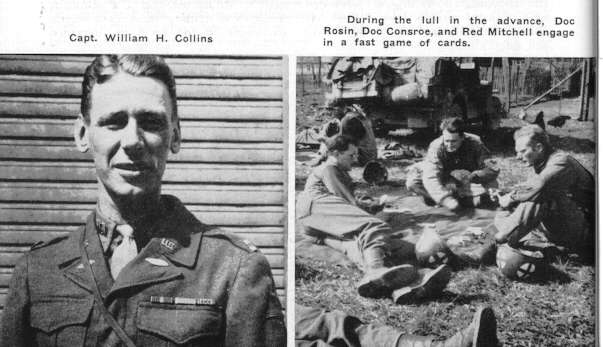
With its mission to secure the high ground northeast of Kalteneber and having once again attached to it "A" Company 50th AIB and detached from it "A" Company 68th, Task Force Davall proceeded to Dinglestadt on the morning of April 7th. We left a block there to protect our exposed north flank, and continued west to Kefferhausen, where advance elements encountered strong small arms and bazooka opposition. The combat team commander immediately deployed "D" (--), commanded by Captain Raymond W. Raines, on the high ground northeast of town, from which point they could support a frontal attack by "FOX" elements, which began attacking up the draw which leads into Kefferhausen. The Reconnaissance Platoon, having meanwhile lost one killed, one wounded, and one missing, withdrew to nearby cover. It soon became evident that the light tanks couldn't adequately cover any further advance by our doughs, and the attacking platoon became pinned down by fire. Then, Colonel Davall ordered their withdrawal, effected with no little difficulty and exposure; having withdrawn, the foot-sloggers took up defensive positions south and east of town. Also, "B" and "C" Companies were deployed in firing positions south and east of town. We requested an air strike, and at 1400 the welcome P-47's bombed and strafed the podunk, during which assault one plane was shot down. In the meanwhile, Dinglestadt had been secured, and several hundred prisoners were taken. Then we withdrew into defensive positions around Dinglestadt, and infantry patrols went into the outskirts of Kefferhausen. We now had "B" Company 50th AIB, but had lost "C" Company, under Captain William H. Collins, to Task Force Ward, which had pushed parallel to and south of us to Wachstedt. Before midnight we had elements of Baker Company 50th in Kefferhausen, and a reinforcing battalion from the 76th Division had joined us in Dingelstadt, although their mission was to push farther northwest and further screen the division's north flank. In addition to losses suffered by our Recon. Platoon, "A" Company 50th lost several wounded and our "D" Company suffered three casualties during the day's operations, which was compensated in part by the heavy casualties which we inflicted on the enemy.
On the following day, proceeding methodically through towns yet swiftly between them, the combat team proceeded from Dingelstadt through Flinsberg, and Kalteneber to Furstenhagen where it closed at 1540. Scattered resistance was met, yet completely cleaned out; with our mission accomplished, we secured Furstenhagen where we awaited further orders, at the same time patrolling actively to the north, south, east, and west. During the latter part of the day we captured forty-three more prisoners in the area.
On the 9th, we continued our widespread patrols to contact elements of the 3rd Cavalry Group, reported to be coming up from the southeast and cast. Finally "A" of the 3rd Cavalry Reconnaisance Squadron and "B" of the 43rd Cavalry Reconnaissance Squadron were contacted. Also, we contacted elements of the 69th Division. So, as their relief of us began, the combat prepared to return to Mulhausen.
The following morning, we proceeded directly to Mulhausen, and all attachments were returned to their parent units. Maintenance and refitting were again begun, while the command anticipated further movement to the east and remained in CCR.

On the
11th, we took off again, as the entire division was on the move, Having
again lost "A" 68th and gained "A" 50th Combat Team Davall made a fifty-three
mile advance to Liebstedt. As part of the CCR column, we breezed through
Hongeda, Dollstadt, Witerda, Kleinrudstedt, and Hottlestedt to Liebstedt,
There was considerable enemy activity over the column during the day, and
our maintenance elements were bombed and strafed near Udestedt. Smashing
along, virtually unopposed and gathering up prisoners in the manner of
a reaping machine, we pushed off again and proceeded
south to Pfuhlsborn; thence we moved southwest to Gosserstadt where we
joined the other elements of the division who were preparing to cross the
Saale River at Gamburg. The column went into assembly there and awaited
its turn to cross the bridge, remaining unusually widely dispersed, as
the threat of enemy air was great. At 1310 we crossed the river and proceeded
to Nauschutz. Just south of Goldschau, the Reconnaissance Platoon and lead
elements of "D" Company discovered a bridge prepared for demolition. Then
after the attached engineer squad had disarmed the charges, the point encountered
a defended road block. Lead elements immediately dismounted, tanks were
brought up, and under the personal direction of Lt. Col. Davall the opposition
was quickly, disposed of, and ten prisoners were taken. Having consequently
screened through Goldschau, the task force went into assembly beyond town,
awaiting further orders. At 1750 we moved out again to Meinweh, where a
road block and small arms fire was encountered, "B" Company immediately
by-passed the town, and barrelled down the main road to Doschwitz to clean
it out and secure it. This proved no easy task, but by 2200, Captain Russell's
men with only seven tanks, but meanwhile reinforced by "C" Company 50th,
had the burg well secured. Sporadic sniping from the outskirts continued.
A patrol was organized, and set out by circuitous route to check on the
condition of the underpass and river bridge just east of Zeitz. Both were
reported intact, and in the meantime the 1st Bn. 304th Infantry had joined
and reinforced our force at Doschwitz. The infantry then began to make
plans for a co-ordinated attack on the city the next morning, and during
the remainder of the night considerable artillery and counterbattery fire
was drawn by our supporting artillery. During this day's operations an
estimated 150 prisoners were taken.
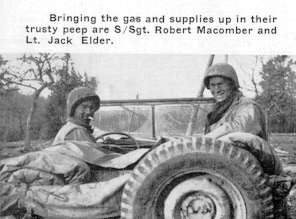
On the 13th, Companies "A," "B," and "C" and the Assault Gun Platoon took up firing positions generally along the river bank southeast, west, and northwest of Zeitz, prepared to fire on definite targets in support of the attack by the footslogging sad-sacks. "A" Company found the formerly O.K.ed bridge now K.O.ed, so the infantry assault was held up; suitable river crossings had first to be reconnoitered. Eventually the doughs forded the river at several points, and with the close support of the above mentioned companies moved into Zeitz. Prior to this, our Assault Gun Platoon suffered heavy shelling while refueling. Then, Company "B" and elements of Company "A" crossed the Weisse River at a shallow point, and "B" company continued to closely support the infantry as they cleaned out the city. Heavy mortar, dual purpose ack-ack, and severe small arms fire was undergone during the expansion of our bridgehead here. Also all the while engineer attempts to improve the ford or construct a bridge were interrupted by heavy direct and indirect artillery fire, But, the afore-mentioned Baker tanks supported the doughs heroically in the cleanup of Zeitz; the remainder of the combat team left Grana, and crossed the Weisse farther downstream at Wetterzub. We picked up "B" Company here, and continued on, methodically and rapidly cleaning out Gleina (where more Allied P.W.s were liberated, and several prisoners taken). Then in succession came Sabissa, Zipsendorf, the railroad bridge there secured, and Schleiditzrossitz. It should be noted here that after leaving Zeitz; the combat team's objective was extended farther east several times, so successful and rapid was its advance,
Since the burgemeister had declared Altenburg an open city, the combat team contained and guarded several important installations and materiel warehouses until relieved by following infantry. Then, at noon, we moved east again, and in quick succession passed through Windischleuba, Dolsenhain, Landau, Corba (at this point we had a bridge across the Mulde River blown in our face), We quickly found another bridge several kilometers south and crossed in the vicinity of Cossen. At 1730, the column, now pointed by "B" Company passed through Koenigshain, and Mittweida, and thence to Erlau, where they closed at 1810. Patrols were set up, and so contact with nearby units was maintained.
This point
is the farthest east that the combat team as a whole had penetrated into
the Reich. As a matter of fact, our task force had marched some sixty to
a hundred kilometers beyond the occupational zone boundaries assigned to
the U.S.A. at the Yalta Conference, We were way out in front; Germany had
been split wide open, and was bursting at the seams. This point in time
as well as distance also marks the virtual termination of combat in the
ETO for the 68th Tank Battalion. Of course, we know that V-E Day was not
declared until several weeks later, but for all intents and practical purposes
we were through fighting. We were not sure of this, however, for the action
still went on north and south of us. We were way out there, and so we waited
and waited until the Russians joined us. We maintained law and order, and
moved from billet to billet, never very far, or for very long. Then, at
last the big boys made it official, and on May 12th we were told it was
all over, that hostilities had ceased, and the Germans had surrendered
unconditionally. Strangely enough, this announcement brought no wild demonstrations
of joy. Rather, we were glad it was over, were secretly proud of the part
we had played in this final victory and all that succeeded it, were sorry
that our fallen comrades could not be there in Eschfeld with us on that
day.
FINISH
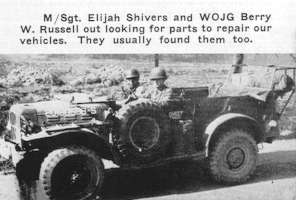
NOTE: Remove question mark from address below when sending email
This page is maintained by Bruce Frederick, EMAIL
.
Last updated: June 12, 1999.